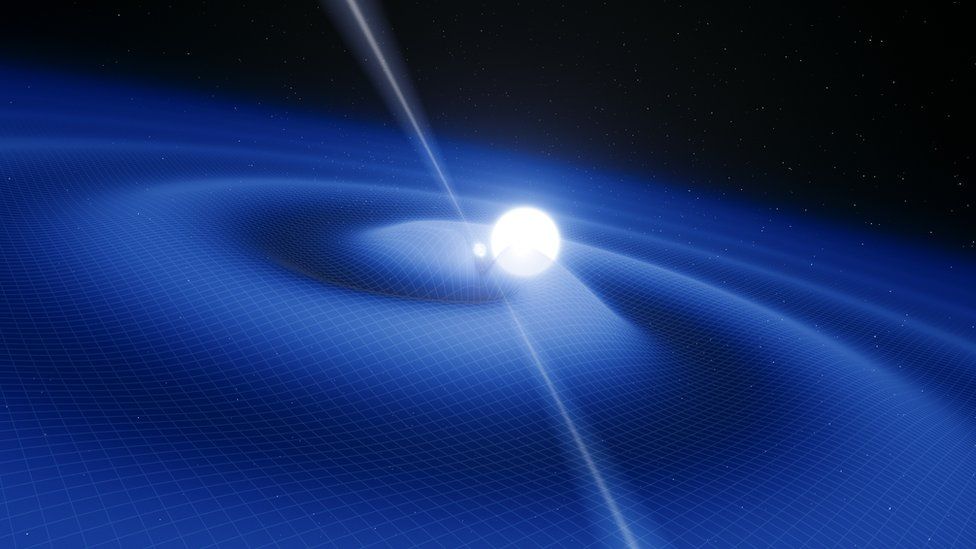'Update' due on gravitational waves
- Published

Anticipation is building ahead of a "status report" from an international effort to detect ripples in space-time.
These gravitational waves were first proposed 100 years ago by Albert Einstein, as a key prediction of his Theory of General Relativity.
But in decades of searching they have never been detected, despite several years of operation from two huge laser instruments in the US and one in Italy.
Teams from the US detectors will speak in Washington DC at 15:30 GMT Thursday.
Speculation is rife that they will announce the detection of gravitational waves by both the US instruments, which together make up the Laser Interferometer Gravitational Wave Observatory (Ligo).
Radiating rumours
"It is so exciting if this really is the first clear detection, as we're expecting," Dr Carolin Crawford from Cambridge University told the BBC's Today programme. "It will really mark a new era for astronomy."
Gravitational waves are concentric ripples that squeeze and stretch the fabric of space-time. They are caused by the movement of mass, but most are so weak that they have no measurable effect.
For current technology to glimpse them, we need to find the waves - still incredibly subtle - that are radiating across the cosmos from extremely violent events, like explosions or collisions involving stars or black holes.
At each Ligo detector, a laser beam is split in two and sent down identical, perpendicular 4km tunnels - then reflected back again. The two arms work like rulers, at right angles, made of light.
If a gravitational wave throbs past, light in one of those beams will travel further than light in the other - by a tiny, tiny fraction of the width of an atom.
Ligo's two stations are 3,000km apart in the states of Louisiana and Washington - allowing them to compare notes on the timing and apparent direction of any such disturbance.
Rumours have been circulating for weeks that both instruments had indeed picked up a signal, and that researchers were working on a paper about the discovery.
It was only in September 2015 that these detectors went back into operation, after a $200m upgrade that saw the facility redubbed Advanced Ligo and dramatically boosted its sensitivity.
Its first run, from 2002-2010, had drawn a blank.
The waves alternately stretch and squeeze space in different directions
Similarly, the Virgo instrument in Italy - built according to the same design - closed in 2011 after an empty-handed four years of "listening".
That project's next incarnation, Advanced Virgo, is due to start work later in 2016.
If detection of these waves is now a reality, astronomers have a very powerful new tool for studying the universe - especially once three detectors are online, allowing the source of the ripples to be triangulated.
Gravitational waves will join the myriad types of light, plus some particles like neutrinos, that scientists already use to probe the far reaches of the universe.
- A laser is fed into the machine and its light is split along two paths
- The separate beams bounce back and forth between damped mirrors
- Eventually, the two light paths are recombined and sent to a detector
- Gravitational waves passing through the lab should disturb the set-up
- Theory holds they should very subtly stretch and squeeze its space
- This ought to show itself as a change in the lengths of the light arms
- The photodetector is designed to capture this signal in the recombined beam
Crucially, because they travel straight through matter, nothing can obscure the source of these waves - there are no shadows. And they could offer an unparalleled "view" of objects that don't emit light, like black holes.
This is why gravitational astronomy has been described as listening to, rather than looking at, the cosmos.
Tuck Stebbins, from Nasa's Goddard Space Flight Center, told the AFP news agency that gravitational waves could even be a window - in fact, the only possible window - on the origin of the universe.
"These waves are streaming to you all the time and if you could see them, you could see back to the first one trillionth of a second of the Big Bang," he said.
Ripples in the fabric of space-time
- The waves are an inevitable consequence of the Theory of General Relativity
- Their existence has been inferred by science but not yet directly detected
- They are ripples in the fabric of space and time produced by violent events
- Accelerating masses will produce waves that propagate at the speed of light
- Detectable sources ought to include merging black holes and exploding stars
- Labs bounce laser beams down tunnels; the waves should disturb the light
- Detecting the waves opens up the Universe to completely new investigations
- Published19 September 2015
- Published25 November 2015
- Published20 May 2015
- Published18 September 2015
- Published12 September 2014